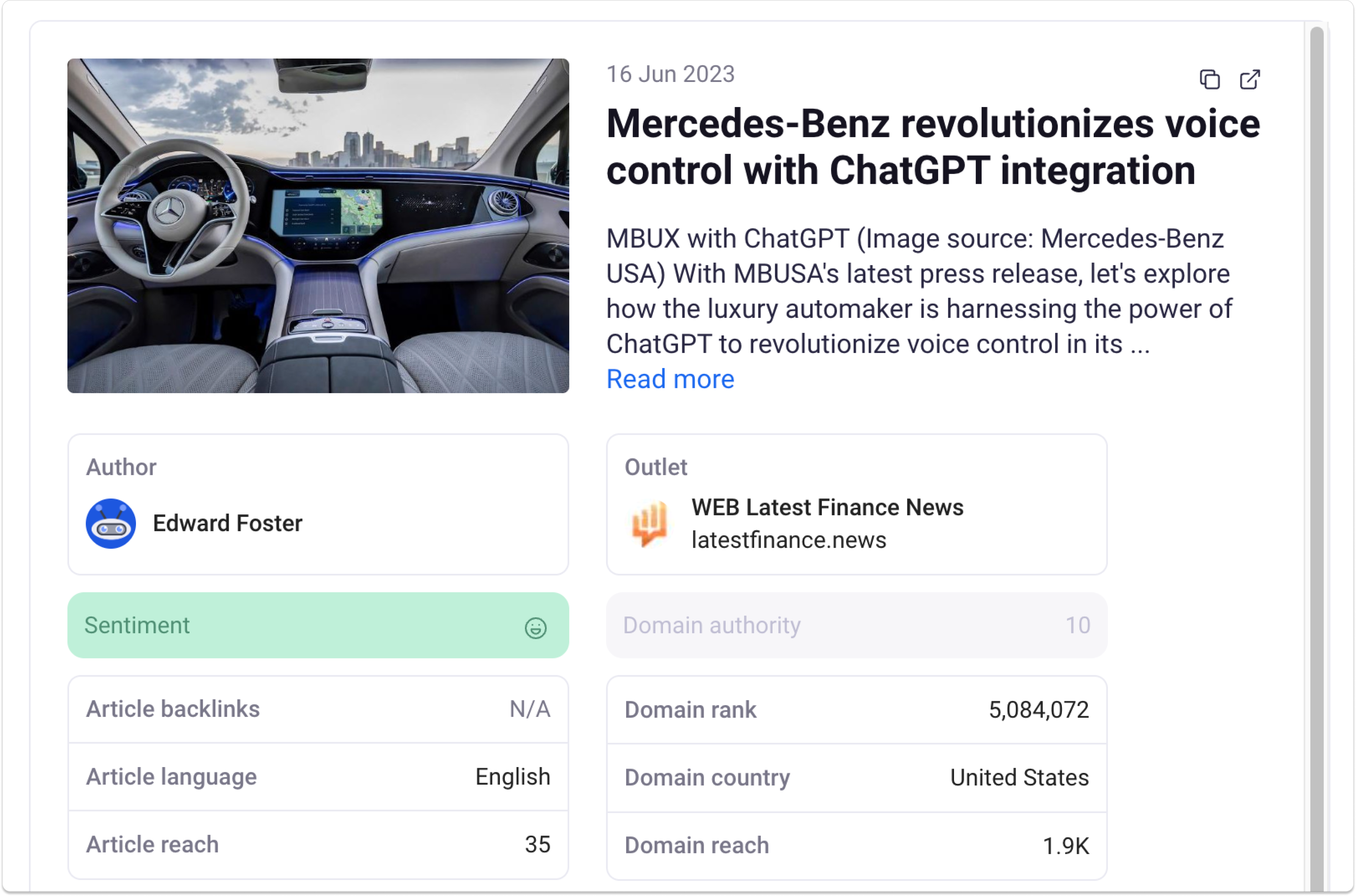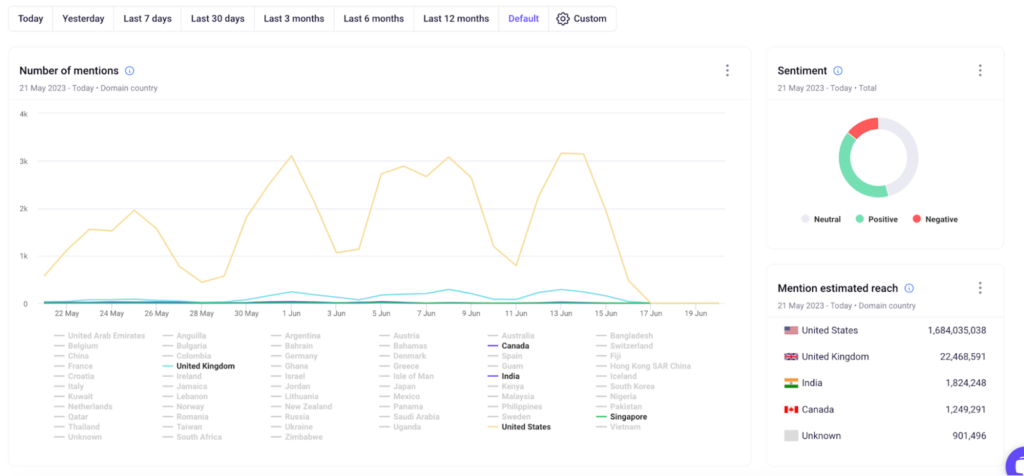How can you develop an effective PR strategy to conquer your industry without knowing who is talking about you and what they are saying? The answer is quite simple - you can’t.
Whether you work at a PR or marketing agency, run your own business, or are a public figure, media monitoring can give you an edge over your competitors and allow you to be one step ahead of everyone else. The key is knowing how to do media monitoring effectively to get the most precise results and information you need.
It’s time to analyze all the business opportunities, past, current, and future trends, as well as emerging crises to take charge of your media presence and reputation. Let’s take a look at how to productively maneuver through media monitoring.
Try Prowly's media monitoring free for 7 days
Start tracking your brand and keywords for free (no credit card required) in Prowly.
- Comprehensive monitoring: Track the web and social media mentions.
- Transparent pricing: Plans start at $258/month
- All-in-one platform: Get everything you need in one tool for PR, incl. media database, outreach, reporting, and more
Who benefits from media monitoring?
Media monitoring isn't just for massive corporations. A wide range of organizations can leverage its power to gain valuable insights:
- Startups and SMEs: Track brand mentions, understand customer sentiment, and identify growth opportunities.
- Large Businesses: Monitor brand reputation, analyze competitor strategies, and manage public relations effectively.
- Advocacy Groups, Associations, and Non-Profits: Gauge public perception of your cause, track campaign effectiveness, and engage with supporters.
- Government and Public Administration: Stay informed about public opinion, identify emerging issues, and improve communication strategies.
- PR and Communications Agencies: Deliver comprehensive media analysis to clients, measure campaign impact, and identify newsworthy angles.
Why monitor the media?
Media monitoring is not just nice to have—it is a necessity.
You need to know who’s talking and what they’re saying about your or your client’s brand. This is not the only advantage, though. The importance of media monitoring goes far beyond monitoring your brand or online discussions.
Here are some examples of why it's crucial to monitor the media:
- Reputation management and crisis prevention
- Measuring brand sentiment
- Measuring PR efforts
- Competitive intelligence
- Market research
Reputation management
A single negative news story, viral social media post, or scathing online review can have a devastating impact on your brand, affecting sales, customer loyalty, and even your ability to attract and retain talent.
This is where media monitoring becomes absolutely crucial for reputation management, whether it’s identifying potential threats or protecting your brand from misinformation
Examples of keywords to monitor:
- Your organization’s name
- Your brand
- Key people
- Product names
- Related hashtags
Real-World Example: Imagine a food company facing a product recall. Media monitoring would alert them to mentions of the recall, consumer complaints, and any related health concerns. This allows them to respond quickly, communicate transparently, and manage the narrative to minimize damage to their reputation.
Brand sentiment
Brand sentiment is how an individual or a group of people feel about your brand, product, services, and overall offer.
Media monitoring helps you track brand sentiment – whether it's positive, negative, or neutral – across various media channels. This data can inform your marketing strategies, product development, and customer service efforts.
Brand sentiment analysis allows businesses to track the overall health of their brand and take action if things go south.
By measuring and analyzing brand sentiment, you can examine how the general public perceives your brand and use this information to direct your sales, marketing and product efforts.
Examples of keywords to monitor:
- Your brand
- Product names
- Your competitors (to use as a benchmark)
Measuring PR Efforts
Public relations efforts aim to shape public perception, build brand awareness, and drive positive engagement. To understand the effectiveness of these initiatives, media monitoring is indispensable. It provides concrete data to analyze the impact of PR campaigns, demonstrate ROI, and refine future strategies.
By tracking media coverage, you can determine if your key messages are resonating, identify which media outlets are most influential, and measure the overall reach of your PR activities. This data allows you to prove the value of your PR efforts and make data-driven decisions.
Examples of keywords to monitor:
- Campaign-specific hashtags
- Press release headlines and key phrases
- Spokesperson names
- Targeted media outlets
- Industry-relevant publications
- Specific event names
Real-World Example: A tech company launches a new product with a targeted PR campaign. They monitor media coverage to track mentions of the product's key features, the tone of the articles, and the reach of the campaign. They also track social media engagement with campaign-specific hashtags. This data allows them to measure the success of the campaign, identify which media outlets were most effective in reaching their target audience, and demonstrate the value of their PR investment to stakeholders. Further more, they can see if the key messages they wanted to push out were the messages that were actually received.
Market research
Staying informed about market trends and customer preferences is crucial for staying competitive.
Media monitoring can provide valuable insights into what consumers are talking about, what their needs and pain points are. This information can help you identify new opportunities, develop innovative products, and improve your marketing strategies.
Examples of keywords to monitor:
- Industry keywords
- Your competitors
- Emerging trends
Real-World Example: A beauty company monitors social media discussions about skincare. They notice a growing interest in natural and organic products. This insight can inform their product development strategy and lead them to create a new line of organic skincare products.
Competitive intelligence
Keeping tabs on your competitors is essential for staying ahead of the curve. Media monitoring allows you to track their activities, identify their strengths and weaknesses, and learn from their successes and failures. This information can help you refine your own strategies and gain a competitive edge.
Examples of keywords to monitor:
Your competitors’ brands
Your competitors’ products
Competitors’ marketing campaigns
Real-World Example: A car manufacturer monitors media coverage of its competitors' new models. They analyze the features that are being highlighted by reviewers and the customer feedback on those features. This information can help them identify areas where they can improve their own products.
Where to look for media mentions?
Nowadays, the number of places where your brand can be mentioned in the media is almost endless.
Where once mentions were confined to print and broadcast media, the internet has opened up a plethora of online platforms—news sites, blogs, social media, and forums—where anyone can discuss your brand.
Online news and blogs
A recent report shows online media has overtaken TV as the top news source in the UK.
Often divided into tiers, online news can include anything from top-tier national publications to industry-specific publications, blogs, and community-focused local news sites.
Although there’s no official number of tiers, they can be divided into the following groups:
- Tier 1 (Top-Tier): Broad reach, high credibility, and significant influence; includes major national and international news outlets. Examples: CNN, Forbes
- Tier 2 (Mid-Tier): Focused audience or regional reach; includes industry publications and established online magazines, valuable for targeted demographics. Examples: The Boston Globe, Healthcare IT News
- Tier 3 (Lower-Tier): Niche or local audiences; includes blogs and community publications, important for localized or highly specific marketing. Examples: Blogs, local news, niche industry publications
When monitoring the media, tracking all publications, especially the smaller ones is crucial. Although they have less traffic, their relevant audiences can be more impactful than mentions in tier-1 publications.
SEO and backlinks
The benefits of being mentioned on online news sites go beyond extra visibility and trust for your brand. Backlinks from topically related websites—especially those with a strong domain authority—can increase your rankings in search engines and, as a result, boost traffic to your website.
When checking your mentions for SEO, look at the following metrics:
- The domain authority of the website where you’re mentioned
- The estimated reach of the article
- If the mention contains a backlink to your website
A mention doesn’t always guarantee a link back to your site. Media monitoring tools like Prowly, can help you find unlinked mentions and convert them into valuable backlinks.
Don’t forget the comment section
Some news sites—especially smaller ones—and blogs contain a comment section, which can hide additional mentions of your brand. Don’t forget about these, especially since they can include unmoderated negative comments that everyone else can see.
Brand mentions here can be useful and offer real insights into what your consumer base thinks, regardless of the tone of the article.
Social media
Monitoring social media platforms is one of the most important business analytics processes. To stay informed about your audience and listen in to what they have to say about you, it’s crucial to monitor the top platforms.
- X (formally Twitter)
- YouTube
- TikTok
An effective media monitoring tool will help you filter information in the posts, replies, and even comments from other users. Once you get that information, you can then gather insights from the reactions and sentiments your audience has about you, a brand, or a campaign.
Discussions and communities
Social media platforms and comment sections aren’t the only places where people can express their opinions about your brand.
Discussion sites, forums, and communities can be a goldmine for media mentions. And with Google preferring user-generated content recently, it’s possible for mentions on forums to get indexed in search results—and stay there for everyone to see.
Depending on your industry and field of expertise, there are several online communities to monitor. These include:
- Reddit,
- Quora,
- Stack Overflow,
- Steam,
- and many more.
Finding online forums and communities may not be the easiest thing to do if you have a niche business, but that’s why tools like daily media monitoring are priceless. Not only will you know what they are saying about you, you will also be able to locate your target audience and which online networks they frequent the most.
Once you have gathered all the data from media monitoring, what's next? If you're looking for the best way to present the data, you need to create a media report.
What information should I monitor?
Now that you know where to look, it’s time to evaluate what information you should be monitoring exactly. Having all the data is the first step, but knowing what to do with it is an art in itself.
There are tons of different ways on how to do media monitoring. Most of the time, these depend on what you are trying to accomplish and your respective end goal.
Are you monitoring the newest campaign and watching reactions and the sentiment your audience has towards it? Are you trying to gain more in-depth knowledge about the competitors you have in a particular niche industry? Or maybe you simply want to measure the strength of your current strategies against previous approaches?
To use media monitoring effectively, you should ask yourself what are your goals and do they align with your KPIs or other relevant objectives.
A media monitoring software can help you better understand your target audience, evaluate your strategies, analyze your brand perception and reputation, identify potential influencers and journalists you’d wish to contact, and much more.
Brand mentions
By looking at who is mentioning your brand and where, you can control brand awareness and adjust your PR & marketing strategy. Knowing where your brand is mentioned can help you evaluate who your target audience is, what people are saying about your brand, and even prevent an upcoming crisis.
This method is also relevant for keeping tabs on your own name, company, or even a particular campaign. Not all media monitoring tools are created equal, so make sure to pick one that also shows historical data to examine previous brand mentions as well.

Competitors
Monitoring your own performance and brand is important, but knowing what your competitors are up to is more than just an essential practice you should be implementing in your strategy if you haven’t already.
Taking a closer look at their successes and failures can help you anticipate their next move, adjust your own strategy and gather valuable insights on your own performance against others in your respective industry.
If you know how to do media monitoring well, you can take advantage of their shortcomings and be one step ahead. These are just a few media monitoring tips you can use for competitor analysis:
- Keep an eye on the social platforms they use
- Track their backlinks to create a potential outreach list for yourself
- Find influencers they’re working with
- Set up alerts for their new mentions
- Analyze sentiment in comments and reviews
P.S. For those searching for the best tools for competitor analysis, check out this article.
Suppliers and vendors
Does your or your client’s business depend on external providers? Monitoring the market is important and will help you determine whether suppliers and vendors’ services will be restricted by ongoing restrictions, delivery accidents, or even politics.
It doesn’t really matter if your products are physical or digital. The latter can also be affected by, for example, viruses or bugs. Monitor relevant keywords to know how these sudden changes may impact you or your client and subsequently draft an impromptu response strategy.
Important keywords
Depending on your industry and marketing targets, the bottom line is to keep an eye on everything that might directly or indirectly affect your brand or company. Aside from monitoring the name of your own brand, tracking social media and your competition, there are other powerful ways on how to do media monitoring and get the most out of the tool.
Here are a few examples when playing around with different keywords that might be useful:
1. You’re in the real estate business
Look up keywords such as “apartments New York”, “rent laws 2023”, “luxury real estate Los Angeles”, “worst neighborhoods Connecticut”. These might help you take your business to the next level and spot potential opportunities for earned media coverage.
2. You run a non-profit
Although the keywords you choose have to be related to your specific organization, some of the words and phrases you may be interested in are “tech volunteer”, “healthcare donations”, “goodwill ambassadors” or even the names of major donors and popular journalists that often cover charity and non-profit stories.
3. You do PR for food industries
Depending on the exact branch, you might want to check out keywords such as “food trends 2023”, “food inflation”, “sugar free beverages” and many others.
You get the idea.
Backlinks
I’m sure you’ve heard about the importance of digital PR and how it’s shaping today’s PR industry. Having high-quality, relevant backlinks can boost your online visibility and reputation.
Measuring the number and quality of backlinks can help you acquire new customers and more business. If you have valuable backlinks, these can help skyrocket your position in Google’s results. More importantly, you can always track your competitors’ backlinks as well and see where to find backlink opportunities.
Media monitoring – tips & best practices
Knowing how to do media monitoring effectively is the most important aspect of using the tool itself. Here are a few tips you should implement in your strategy:
Narrow down your search
You will save hours on top of hours by getting the most relevant information you need.
For example, if you run an e-commerce business that specializes in shoes, don’t waste time on all mentions that have the “shoes” keyword.
This tip may be a no-brainer for many PR professionals, but it’s crucial not to get sidetracked by all the possibilities media monitoring has to offer. To get the most precise results, use as many filters as you can.
Watch out for spelling and context
This is perhaps one of the simplest media monitoring tips but happens so often it’s definitely worth highlighting. There are tons of posts on social media that might be talking about you or your brand, but what if they are misspelled? You have no way of finding them.
For example, if your name is “Ana”, try to search for “Anna”, “Anne” or “Ann” as well.
Additionally, check the context of the keyword you’re looking for. While “Apple” is a brand, it’s also a fruit or a name. To get the most optimal results, don’t forget to pick a specific keyword type to match what you’re looking for.
Use alerts to avoid missing opportunities
Whether you’re interested in how well your new campaign or product is performing, it’s smart to stay up to date on any new mentions. A quality media monitoring service should be able to alert you right in your mailbox when something interesting happens.
If you want to save time on reporting your progress, use a tool that schedules daily, weekly, and monthly alerts with AI coverage summaries.

Setting up alerts is crucial to monitor abnormal activity on any keywords, brands, or competitors you want to track. It’s also useful in preventing an upcoming media crisis by receiving updates on a surge in bad sentiment alerts.
Take advantage of sentiment analysis
With a stellar media monitoring tool, you should be able to monitor the sentiment of any keywords and backlinks you’re after. Positive and negative sentiment can help you determine which one of your strategies works well and which developments you should act on immediately or readjust in the future.
Receiving lots of bad sentiment is a sight no PR professional wants to see, but there are ways you can use it in practice other than preventing a media crisis.

For each bad sentiment you found, you can implement a risk management practice and respond to all comments and negative reviews you received.
Organize your mentions
This is a crucial step that will save you a lot of time in the long run. While everyone has their own preference when it comes to organizing their work, there are many features a good media monitoring tool should offer to help you out.
Take your time to file all of your mentions and put them into separate projects. You should also be able to add mentions to clippings, tiers or sort them out by sentiment, country etc. It’s better to do it in the beginning and set yourself up for the future, rather than spend days on organizing mentions down the line.
Psst! Here's a list of the best social listening tools available on the market.
You can also learn all about using social monitoring for PR from The Complete Social Media Listening Guide for Public Relations.
Conclusion
If you want to monitor media content the right way, it’s important to know how to do media monitoring well. The sooner you start monitoring yourself, your brand, or your competitors, the sooner you will be able to gather all insights and use them for your PR and marketing campaigns, new business opportunities, risk management, and much more.
Once you're at it, you might want to check what Prowly has to offer. It's an all-in-one workflow automation solution for PR professionals that supports users in media monitoring, finding the right media contacts, and managing email pitches, just to name a few.
Cover photo by Markus Winkler

